Gardeners across the world proudly bring freshly picked vegetables and fruits into the kitchen. They’re lucky to have an amazing array of delicious plants to grow and enjoy. It wasn’t always that way.
Consider Native Americans. Prior to Columbus, many lived in cities and big towns surrounded by gardens and farm fields. They grew corn, beans, and a diversity of squash and pumpkins, but they knew nothing of many of today’s common vegetables. Residents of Asia, Africa, Europe, and Australia back then also farmed and gardened, but their crop choices were limited.
- Many foods were cultivated by indigenous people.
- Cahokia Mound
New World & Old World

Indigenous contacts ranged far and wide.
It changed quickly following what’s called the Great Columbian Exchange. Shortly after Columbus set foot on Hispaniola people began deliberately and purposefully moving plants and animals around the world. Many were valuable and diversified the food chain on all continents. Others quickly became pests………most weeds infesting American gardens originated in the Old World.
Imagine Southern Italian cuisine without tomatoes! This delicious vegetable originated in South America and was unknown in Italy before the Columbian Exchange. Same with potatoes. The Irish potato originated in South America.
It went both ways. Today’s gardeners enjoy vegetables originating all over the globe. Here’s a brief list of where common foods came from:
NATIVE OF THE NEW WORLD
Pumpkins and squash, Beans except for fava, Corn, Potato, Sweet Potato, Tomato, Pepper, Jicama
- A machete is useful in cutting squash.
- The sweetness of summer’s bounty.
- Sweet potatoes are a healthy vegetable.
NATIVE OF EUROPE, ASIA, and AFRICA
Watermelons and cantaloupes, Onions, leeks, and garlic, Turnips, Carrots and parsnips, Yams, Radish, Celery, Asparagus, Beets, and Chard, are the same species, Cabbage, Cauliflower, Brussel Sprouts, Broccoli – all related, Endive, Lettuce, Rhubarb, Spinach, Okra, Cucumber, Peas.
The Columbian exchange also included grains and fruit. Corn is American but wheat, barley, rye, and oats are from the Old World. Apples, peaches, pears, and cherries (except for the bitter American black cherry) are also Old World. Brambles and strawberries apparently lived in both the Old and New Worlds prior to Columbus. Grapes eaten fresh and used for juice and wine came from the Old World but several species also are native to the Americas.
- A favorite fall harvest is apples.
- Tart cherries come ripe in June.
Thanks to the movement of useful plants gardeners worldwide enjoy a diversity of plants to grow and eat.



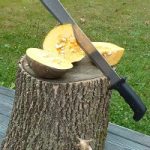
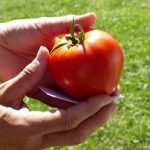
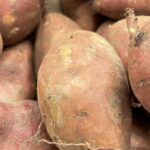
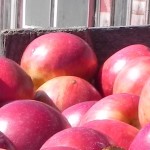
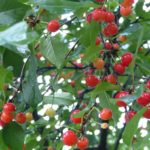

Next year I will grow my carrots in huge pots with potting soil because the garden soil here is primarily clay which the carrots can’t begin to penetrate. I say next year because before it occurred to me that carrots growing in potting soil in a huge pot would do well I had just given up. I came across an interesting article written by a gardener about growing carrots in pots (I can’t remember what magazine.) which inspired me.
Jackie: Raised bed or potted vegetable gardens makes a lot of sense. Our soil is too heavy and rich, too, so we plan to “lighten up” the soil in the future. The carrot top greens make excellent pesto! M~